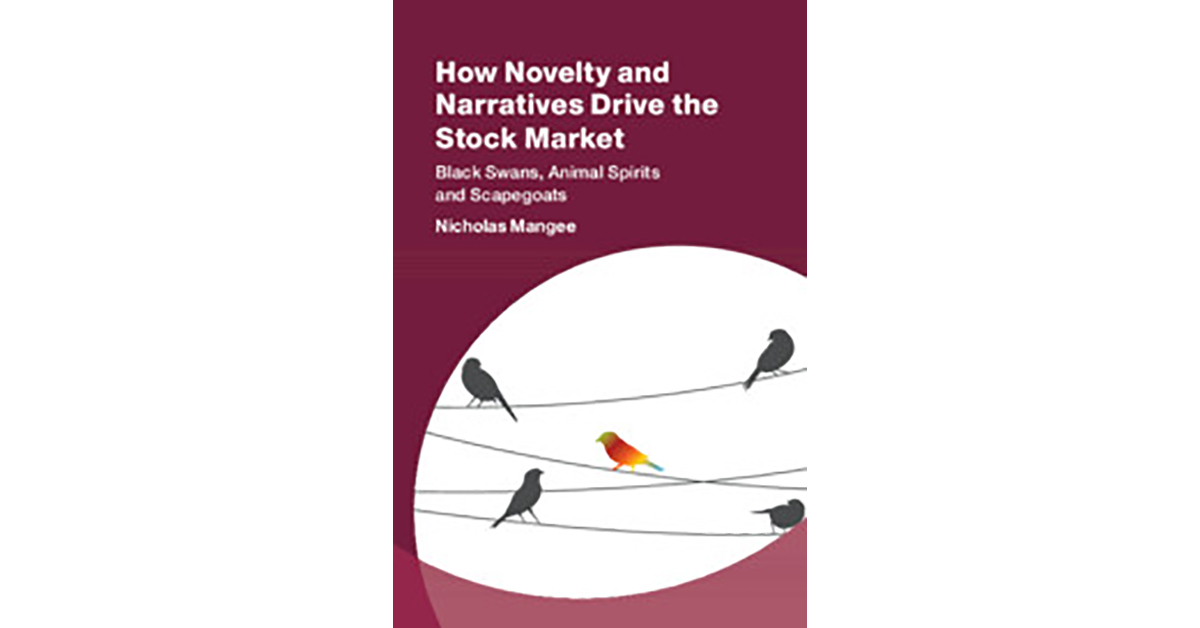[ad_1]
How Novelty and Narratives Drive the Stock Market: Black Swans, Animal Spirits and Scapegoats. 2021. Nicholas Mangee. Cambridge University Press.
“Where there is novelty, there is instability. Where there is instability there is uncertainty. Where there is uncertainty there are narratives — narratives are the currency of uncertainty.”
Nicholas Mangee, associate professor of finance in the Parker College of Business at Georgia Southern University, begins How Novelty and Narratives Drive the Stock Market with a statement that encompasses the problem he tackles and the compelling reason for investor interest in the new-style thinking that addresses it.
This detailed stock market study attempts to extend Nobel Prize-winner Robert Shiller’s development of narrative economics, albeit Mangee’s focus is on novelty information embedded in textual news narratives. Using a set of text-based indices to capture the uncertainty and ambiguity in unscheduled news, Mangee measures the impact of news narratives on equity behavior.
News reports are stories and narratives containing unique information that cannot easily be handicapped or assigned probability estimates for quantifying risk. This novel information confronts investors with “Knightian uncertainty” (i.e., the inability to measure probabilities of future states, as described by the Chicago economist Frank Knight). Molding advances in textual analysis and categorization into a method for measuring nonquantitative information that affects equity prices, Mangee enriches the discussion of stock price behavior by including the mountains of novel and unscheduled information contained in news reports. Attempting to categorize and measure the impact of news and the accompanying narrative is a daunting task, but this book provides a significant advancement well worth an investor’s time.
Textual analysis through natural language processing and machine learning, which has moved beyond the normal scheduled announcement of macro and firm-specific information, has become the cutting edge of quantitative financial research. Mangee links this analysis to the new conception of narrative economics as a driver of sentiment and expectations. He focuses on measurement of uncertainty and ambiguity to enhance our knowledge of stock drivers beyond normally scheduled and repeatable data. Stock market volatility and changes in factor behavior are shown to be linked to the flow of unique information that is collected in financial news reporting.
The book starts with what is called the novelty-narrative hypothesis (NNH) and links this concept with Knightian uncertainty. The NNH states that unscheduled and unique information, which comes in the form of narratives, cannot be easily handicapped but can still affect stock behavior. Novel, infrequent, and unscheduled information is subject to interpretation through narratives or stories in our financial press because there is no good way of converting this information into measurable risks. These novel narratives influence stock behavior even though they represent explanations of uncertain events.
For Mangee, the link between unique news and stock market prediction, an area not usually researched, can offer explanations for heightened volatility, breaks in model behavior, and parameter uncertainty. Unique textual information and novel data can be systemized, encoded, and bundled into categories and indices to provide meaningful information that can support our understanding of stock behavior. Using decades of data from leading news organizations, the author forms what he calls Knightian Uncertainty (KU) indices for macro and micro (i.e., firm-level) data.
Mangee first introduces us to textual analysis using Google trends and word cluster maps to demonstrate how investment themes change in financial news. What captures the attention of news services in a given period may vary markedly over time. From this high-level analysis, the author employs the RavenPack news analytic platform for categorizing textual analysis into macro and micro news categories. These are further divided into uncertainty, sentiment, novelty, relevance, and aggregate event volume indices based on different characterizations for categorizing news events. The resulting categorizations represent a massive effort of taking information from millions of stories by numerous news reporting services across decades to form hundreds of clusters that can be aggregated based on stock-based importance. Millions of new stories are grouped and categorized into close to 1,400 event categories to form indices as tools for measuring various forms of uncertainty.
These textual information indices are associated with swings in stock market volatility. Equity volatility is not driven solely by surprises in scheduled news but also by the broad set of unscheduled and random novel data that can translate into market reactions. For example, increases in KU indices, which measure novel narrative news, lead to increases in stock volatility. Regime changes in equity styles and behavior, as well as model parameter changes, can be associated with fluctuations in unscheduled unique information that is embedded in our news narratives. Studying unscheduled swings in novel news provides a window into market instability that improves our understanding of stock market complexity. What is relevant to investors will change through time, based on sentiment and focus.
This lengthy book is directed at an academic audience and addresses several sophisticated research topics involving uncertainty and text narratives, but its core conclusions and message are accessible for most finance professionals. Scheduled and measurable news matters, but so does the continual flow of commentary and interpretation of the unique information that enters markets every day. Detailed and exhaustive analysis of textual data gives new meaning to market sentiment and the impact of news on stock prices.
Exploring equity reactions through the conversion of textual narratives into measurable indices should be an area of extreme interest for many investors interested in understanding market volatility. It constitutes a new direction for potentially cracking the code for stock market prediction. Mangee provides a solid introduction to a novel approach to explaining equity instability; nevertheless, the complexity of sorting through all the data and attempting to give it meaning is still in its infancy and not easily convertible into investment rules. From novelty comes narrative and uncertainty, but the reader will still ask the question, what next?
If you liked this post, don’t forget to subscribe to the Enterprising Investor.
All posts are the opinion of the author. As such, they should not be construed as investment advice, nor do the opinions expressed necessarily reflect the views of CFA Institute or the author’s employer.
Professional Learning for CFA Institute Members
CFA Institute members are empowered to self-determine and self-report professional learning (PL) credits earned, including content on Enterprising Investor. Members can record credits easily using their online PL tracker.
[ad_2]
Source link









 Bitcoin
Bitcoin  Tether
Tether  XRP
XRP  USDC
USDC  Lido Staked Ether
Lido Staked Ether  Dogecoin
Dogecoin  LEO Token
LEO Token